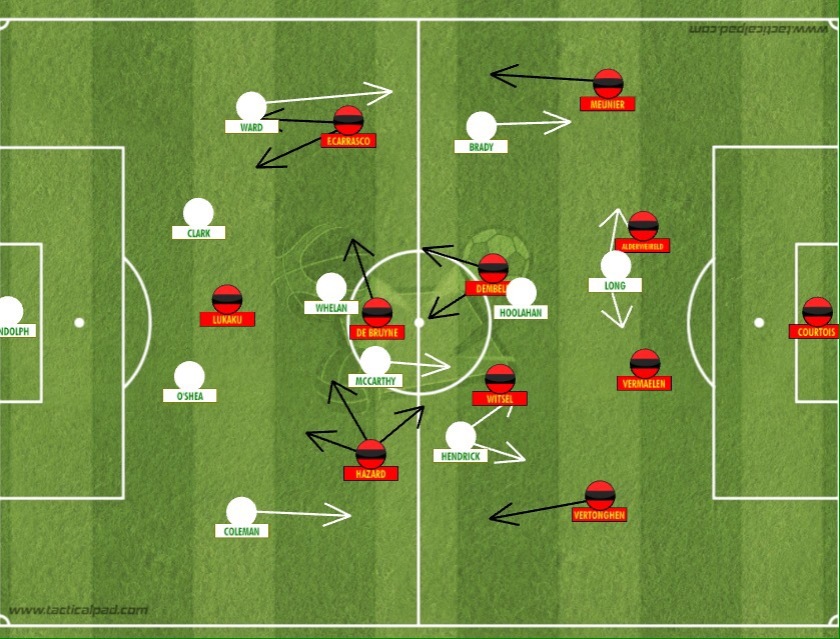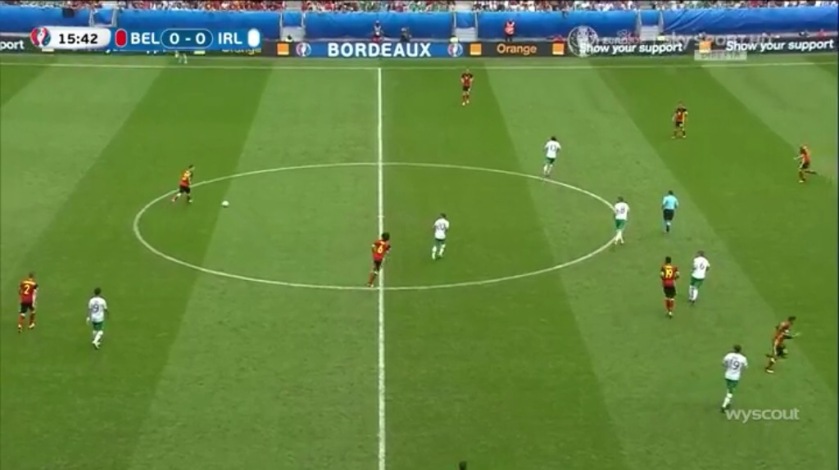Following a widely discussed poor tactical performance which saw Belgium lose 0-2 to Italy, Ireland would be looking to capitalise on a mentally wounded side. The Irishmen impressed in a 1-1 draw with Sweden, where they could have won the game after a number of impressive individual performances. Going into this one, Belgium manager Marc Wilmots simply had to improve the tactics of his team if he wants The Red Devils to become genuine contenders for the Euro 2016 title.

Following their 0-2 loss to Italy, Belgium made three alterations to their starting eleven. Despite a rumoured fallout with coach Marc Wilmots, Thibaut Courtois retained his place as goalkeeper. Thomas Meunier came in for Laurent Ciman, while Alderweireld, Vermaelen and Vertoghen remained in their places. Moussa Dembele took the place of Nainggolan as the right of the two deepest midfielders, Axel Witsel partnered him. Fereira-Carrasco came in the team to the right wing, De Bruyne played as 10, Hazard to the left. Lukaku was the team’s 9.
Ireland were forced into a single change, due to the injury of Walters. Randolph played in goals, protected by a defence of Coleman, O’Shea, Clark and Joel Ward. In front of them was a double-pivot of Glenn Whelan and James McCarthy. Flanking those two were Jeff Hendricks and Robbie Brady. Hoolahan and Long were Ireland’s two most advanced players, as 10 and 9 respectively.

Improved Possessional Structure
Contrasting to their disastrous loss to Italy in the opening game, particularly in terms of tactics, Belgium were strong in possession and their progression through stages of build-up were far cleaner than we seen previously.
The full-backs weren’t used so frequently, with Dembele and Witsel offering sound options throughout being a more useful alternative. Not just against Italy, but all throughout their qualifying campaign, the No.6’s Nainggolan and Witsel played quite high up while the centre-backs were in possession. This left the full-backs as the main option for the centre-backs, which is a well known error when building-up.

“Passing plot from @11tegen11 showing the extent to which Belgium used their full-backs.”
Building through the full-backs means just the near halfspace can be accessed while the full-back is in possession. This makes pressing far easier for the opposition as they only have to worry about one side of the pitch the time being, whereas when the ball is in the centre, either halfspace or wing(through a long pass)can be accessed, meaning the opposition defensive shape will be more stretched as coverage is needed over wider area.
Against Italy, Belgium had serious issues with clean progression as Italy’s defensive system worked perfectly in regards to Ciman and Vertonghen being the most frequently used players in build-up.
https://twitter.com/1415football/status/742476195405660162
With Dembele, one of the strongest players in the English Premier League in build-up, coming into the team in place of Nainggolan, this opened up more possibilities for Belgium to utilise their strength in the centre during build-up. Although Nainggolan is competent in possession, he is more of a box-to-box midfielder and doesn’t offer the same qualities Dembele can offer in build-up. This meant Witsel wasn’t needed to dictate so much from 6 or 8 positions as he now had a partner capable of doing so.
In this match, Witsel frequently dropped between Alderweireld and Vermaelen, who now had stability to split wide.

As this happened, Meunier and Vertonghen advanced forward, onto the same line as Moussa Dembele. With Ireland defending so deep and Long being the only presser on the frontline, Courtois often had three simple passing options. When the play began, Alderweireld, Witsel and Vermaelen would horizontally circulate to manipulate the positioning of Ireland’s compact midfield. When a lane to Dembele opened up, a quick vertical or diagonal would be played to the Spurs man, who would then look to carry the ball forward. We saw good dynamics from the Belgians at this point, as De Bruyne moved into the right halfspace to open space up for Dembele to drive into, while Hazard drifted infield to his favoured left halfspace. Witsel also pushed up closer to Dembele, to be there in case the attack needed to restart and possession recycled.
Change of Shape and Ireland’s Transition
Like Belgium, Ireland made a tactical alteration from their opening match.
Against Sweden, the Irishmen defended in a 4-1-3-2.

The main ideas of this system was to initially force Sweden into building through their full-backs by Long and Hoolahan/Walters angling their body to force these passes. As the ball travelled to the full-backs, Ireland would laterally shift into positions surrounding the ball. When the full-back received, either the full-back or ball-near midfielder would engage in a press, angling their body shape to force a pass infield, usually to Ekdal or Kallstrom in the halfspace. As this pass was made, Ireland players close to the ball would create a pressing trap to force Sweden play a negative pass, or win the ball back in a good area.
In this match though, Ireland retained the same pressing trap idea, but in a different formation. A 4-2-3-1/4-4-1-1 was deployed out of possession.

Again, Shane Long attempted to force the opposition to build through the full-backs, but with Witsel dropping to form a back three so often, this was a difficult and wasteful amount of running for him. Belgium were often able to escape the press easily. Even if Belgium were forced to the full-backs and the pressing trap was sprung, with players such as a Hazard and Dembele in the halfspaces, quick combinations in a small space were often used to escape the press and continue to progress.
With Wes Hoolahan not pressing the same he did against Sweden, instead leaving this to Long, he was often quite a distance away from the striker. A fatigued long was often unable to get back in position quickly, and while Ireland dropped into a very deep block, he became very isolated in turnovers. Defending so deep, Ireland’s main escape route was to play a long ball to their only outlet, Long. The Southampton striker usually had no support whatsoever though, and was often flicking a header or knock-down to nobody. This simply allowed Belgium to restart the attack and begin another wave of pressure on the Irish goal.
Conclusion
A significantly improved structure during build-up saw Belgium run out as convincing winners against an Irish side who lacked any real quality in or out of possession. The inclusion of Moussa Dembele provided Belgium with the large lift they needed following a morale-damaging loss midweek. Although the Tottenham midfielder limped off injured around the hour mark, his qualities were deeply missed in the opening match, but his dynamic use of possession was very effective in this match. Although finishing top of the group seems unlikely, relying on an Irish win over Italy, Belgium’s last group game, against Sweden, is very significant as it will decide on qualification or not.

